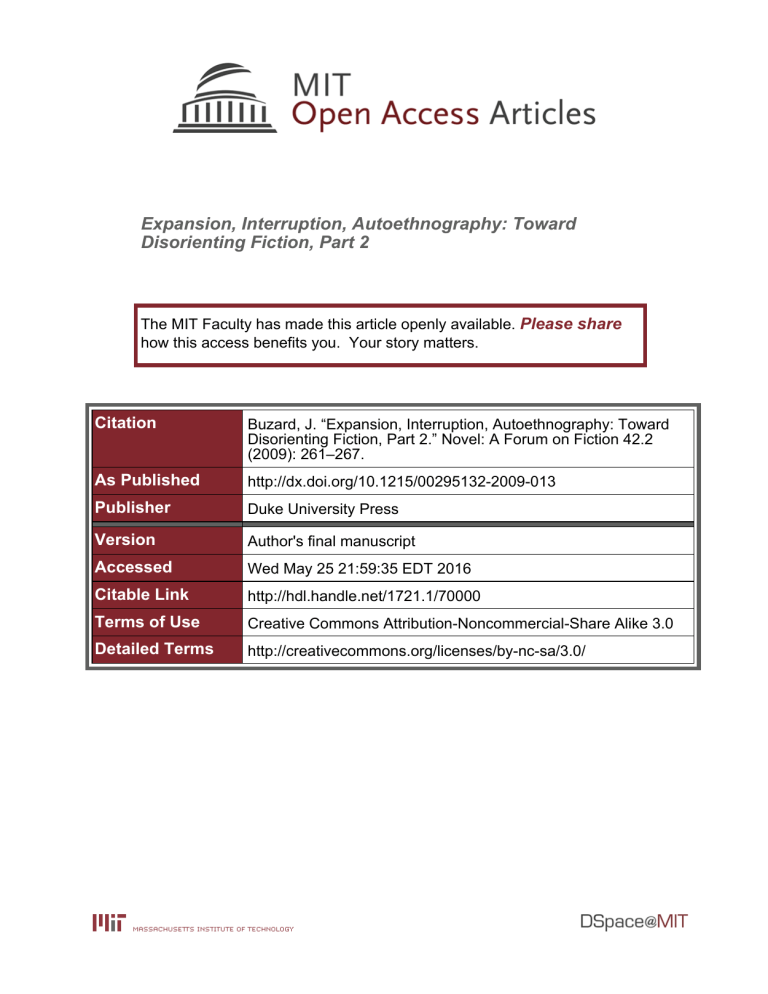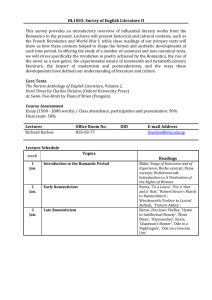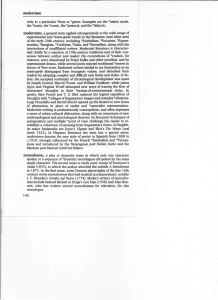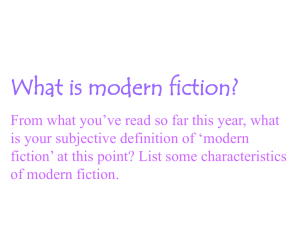Expansion, Interruption, Autoethnography: Toward Disorienting Fiction, Part 2 Please share

Expansion, Interruption, Autoethnography: Toward
Disorienting Fiction, Part 2
The MIT Faculty has made this article openly available.
Please share
how this access benefits you. Your story matters.
Citation
As Published
Publisher
Version
Accessed
Citable Link
Terms of Use
Detailed Terms
Buzard, J. “Expansion, Interruption, Autoethnography: Toward
Disorienting Fiction, Part 2.” Novel: A Forum on Fiction 42.2
(2009): 261–267.
http://dx.doi.org/10.1215/00295132-2009-013
Duke University Press
Author's final manuscript
Wed May 25 21:59:35 EDT 2016 http://hdl.handle.net/1721.1/70000
Creative Commons Attribution-Noncommercial-Share Alike 3.0
http://creativecommons.org/licenses/by-nc-sa/3.0/
James Buzard
Expansion, Interruption, Autoethnography:
Toward Disorienting Fiction , Part II
In Myth, Rhetoric, and the Voice of Authority (1992), Marc Manganaro called attention to a remarkable asynchrony between modernist literature and the already outmoded
Victorian comparativist anthropology it fed upon. At the very moment when anthropology was making its decisive turn away from the evolutionist paradigm of a single, world-encompassing, capital-C Culture and toward a vision of spatially distributed, plural, small-c cultures – at just that moment when Boas, Malinowski, and others were putting paid to the model of the “armchair” comparativist and inaugurating the new ethnographic regime of participant-observation fieldwork and of the monograph offering an authoritative grasp of one entire, functionally integrated culture – at just that moment, modernist authors like T. S. Eliot (notably, in his 1923 review of Joyce‟s
Ulysses ) started assiduously to appropriate the authority of such massive, multi-volume, world-explaining studies as J. G. Frazer‟s The Golden Bough and its ilk. In Manganaro‟s account, the literary modernizers of the 19-teens and „20s lagged curiously behind those in the consolidating academic discipline of anthropology. I start here, first, because I have rather rashly promised, in Disorienting Fiction: The Autoethnographic Work of
Nineteenth-Century British Novels (2005), to write a second volume that will carry on my argument through the later nineteenth century and on into the heyday of modernism, and second, because numerous critics writing more recently that Manganaro in 1992 –
1
including Manganaro himself, in his 2002 book Culture, 1922: The Emergence of a
Concept , as well as Susan Hegeman, Jed Esty, and others – these critics have tried to resituate and realign literary modernism and the modern, small-c concept of ethnographic culture. This more recent criticism differs from the Manganaro of 1992 in finding that the connections worth exploring lie, not between modernism and Victorianist comparativism, but between modernism and its anthropological contemporary, pluralistic fieldwork ethnography. Such efforts will be sure to complicate my own as I seek to extend the thesis of Disorienting Fiction ; this paper attempts to identify and to begin to strategize about these and other such complications.
Disorienting Fiction works with a different, in fact complementary asynchrony between literature and anthropology than the one Manganaro highlighted back in the early 1990s, an asynchrony brought to my attention around that time by Christopher Herbert‟s wonderful book Culture and Anomie: Ethnographic Imagination in the Nineteenth
Century (1991). This study tracked a not-yet-emergent, unnamed “culture idea” across several important nineteenth-century discourses, among them cultural criticism, social reportage, missionary writing, and political economy. Before the word “culture” in its small-c plural usage achieved articulated existence, before it became anthropology‟s special object of study, Herbert contended, the intellectual work of the concept was already being done, covertly, in these and other discourses: Herbert‟s subject was the
“turbulence” caused across the whole Victorian discursive field by the operations of the embryonic culture idea, and Culture and Anomie ranged broadly and brilliantly across that field. But Herbert‟s treatment of the novel seemed to me the most questionable element in a powerful work. In a chapter on “The Novel of Cultural Symbolism,”
2
Anthony Trollope emerged as the lone exception to the rule in nineteenth-century English fiction, the purported rule of “His Majesty the Ego,” according to which novels typically foreground character against social backdrop and must thus be regarded as antiethnographic in tendency. Only in Trollope, we were told, did the individual and the social network in which she was embedded merge into proto-ethnographic unity. For reasons I explore in my book, I found such an exceptionalist argument and such a characterization of the “typical” novel, from which Trollope supposedly diverged, unconvincing. And so Disorienting Fiction goes about exploring what I see as the anticipation in nineteenth-century British prose fiction of precisely that fieldworking, pluralistic model of doing anthropology that was to dominate twentieth-century practice and that centered on the dyad of the single, small-c culture and the participant observer whose peculiar vantage point was required to perceive it. The book‟s thesis is gestured at by the three words of this paper‟s main title: nineteenth-century Britain‟s imperial expansion is the ultimate context in which to make sense of the nineteenth-century novel’s
apparent commitment to an autoethnographic enterprise aimed at writing into existence a delimited and distinctive culture for the English or even the British people, at a time when there was every encouragement for them to regard their way of life as exhausted in identification with a globally exportable “Civilization” or capital-C
“Culture” itself. That delimiting impulse found expression in what I call the “selfinterrupting” features prominent in Romantic-era and Victorian narrative.
Disorienting Fiction (henceforth DF) covers (more or less) the period 1800-1860; the sequel (DF II) would run from around 1860 to the 1920s. Among the challenges facing that sequel are some arising from the first book‟s emphasis on the novel‟s production or
3
evocation of a specifically national culture, for how can a national autoethnographic project be seen as extending into a modernist movement generally understood as a definitively cosmopolitan phenomenon, the work of exiles, émigrés, expatriates? I have argued elsewhere that the late modernism of the 1930s and 1940s in Britain “had largely made its peace with nationalism [and] embraced its Britishness” (“Mass-Observation”
98), and Jed Esty has explored at length what he calls the “autoethnographic turn” in
British literature of the same decades (see Esty 36-46), but the status of the national in modernism‟s formative period remains problematic. The implication of Esty‟s thesis about the autoethnographic turn, of course, is that in the 1930s and 1940s British literature turned away from something not autoethnographic in tendency (which something could conceivably stretch back to include the Victorian period as well as the first decades of the twentieth century). Problematic as well is the focus on a specifically
English or British national identity. Legitimizing such a focus means having to contend with the small but significant body of critical literature advancing exclusivist arguments about other national contexts than that of Britain. A number of critics, for example –
Hegeman, Nancy Bentley, Walter Benn Michaels, Michael Elliott, Brad Evans – see the modern ethnographic imagination as emerging in the distinctive environment of the
United States and consider its relationship with aesthetic movements solely in that connection. Gregory Castle‟s
Modernism and the Celtic Revival , for its part, makes the case that “no European modernist context save that of the Anglo-Irish Revivalists” presents us with the same, definitive conflict between “civilized observer and primitive society” that we find in the foundational texts of modern ethnography (Castle 29).
Castle‟s argument will be sure to inform my own about Joyce, whose vexed relationship
4
to Irish cultural nationalism has long been recognized; yet I share Carey Snyder‟s recently expressed view that Castle “sequesters the rhetorical modes of the Celtic Revival from mainstream modernism, failing to appreciate the importance of the ethnographic to modernism in general” (Snyder 15). Snyder‟s own
British Fiction and Cross-Cultural
Encounters: Ethnographic Modernism from Wells to Woolf (2008) “extends and complicates” the perspective of DF. On her account, modernist novels focusing on encounters with alien peoples ( The Voyage Out , Heart of Darkness , A Passage to India , and others) seem to have been better at raising the epistemological, political, and ethical challenges those encounters evoked than were the early ethnographers themselves, preoccupied as they were with professional self-justification and dependent as they were likely to be on colonial institutions. It is in the cauldron of the ethnographic encounter,
Snyder suggests, that “many of the central tropes and aesthetic devices we have come to associate with modernist literature – including the use of multiple perspectives, the showcasing of incoherent identities, and the pervasive trope of disorientation” – get created (11). This aspect of Snyder‟s argument is in some ways similar to Manganaro‟s somewhat more theoretically robust one in Culture, 1922 , for the latter book too is concerned with the textual effects common to modernism and ethnography, though
Manganaro attends to a different, Anglo-American modernist canon.
DF was written to offer a new kind of answer to a widely perceived phenomenon of much nineteenth-century British fiction: the virtual absence from its pages of colonial spaces and subjects, at a time when the British underwent unprecedented expansion and the colonies grew ever more essential to the maintenance of the British way of life (but see
Moretti, Atlas 24-26). DF II will have to deal with the emergence of fiction of the sort
5
Snyder examines, the late-nineteenth and early twentieth-century texts that, turning away from the domestic confines of the Victorian novel, are frequently set in the colonies and overtly preoccupied with colonial issues. Such texts make up a subset of a turn-of-thecentury group of writings DF calls the “maelstrom from which the Participant Observer and the correspondingly plural and spatialized conception of culture arose into articulated form and commenced their careers at the heart of a single discipline asserting primacy over all matters cultural” (11). This corpus, which encompasses various forms of fiction
(among them detective, utopian, espionage, sci-fi) as well as ethnography, travelogue, psychoanalysis, and philosophical hermeneutics, exhibits a fixation on processes of controlled, temporary self-alienation (see DF 9-10). Just as DF, in making its case about
“the autoethnographic work of nineteenth-century British novels,” did not confine itself to novels set in Britain but, rather, examined both novels with exclusively domestic
British settings ( Bleak House or Jane Eyre , for example) and novels set largely in foreign lands ( The Professor or Villette , e.g.), so too must DF II treat of both kinds. It is not only on British soil that British autoethnographic imagining goes on. To say this is simply to discern the kernel of autoethnography in the ethnographic encounter: Malinowski contended, and many others have agreed, that one valuable result of doing participantobservation fieldwork in another culture was the productively defamiliarized perspective it yielded on one‟s own. DF II will necessarily have to consider (for instance) both
Howards End and A Passage to India , Tono-Bungay and Heart of Darkness , and to grasp the relationship between these.
DF II will also have to contend with the emergence of official academic anthropology in the last decades of the nineteenth century: the discipline gained its own section of the
6
British Association for the Advancement of Science in 1874, and works such as E. B.
Tylor‟s Primitive Culture (1871) and, of course, Frazer‟s The Golden Bough (several editions up to 1922) were widely discussed in extra-academic circles. The challenge here will be to assess what Christopher Herbert would call the “turbulence” caused in novelistic discourse by the growth of this academic discipline and the dissemination of its ideas – which for their evolutionist comparativism were antithetical to ethnographic or for that matter to autoethnographic thinking. How did the institutional authority of an anthropology that understood its object – human culture – as a singular, universal phenomenon affect the production of novels that, I have argued, anticipated the twentieth-century fieldwork form of anthropology in incubating a pluralizable and spatially demarcated culture concept (and the participant observer who studied it)? What alterations, deformations, mutations of the autoethnographic model developed in British fiction from (roughly) Scott to George Eliot can be discerned, thanks to the magnetic force of contemporaneous anthropological discourse, in later Trollope or in Hardy or
Conrad – or in Woolf or Joyce? How does the evolutionist, single-scale model of capital-
C “Culture” or Civilization enshrined in nineteenth-century anthropology insert itself, anamorphically, into the British novel, and what gets displaced by its insertion? (I am thinking here of Stephen Greenblatt‟s well-known reading of the anamorphic death‟s head in Holbein‟s
The Ambassadors , from Renaissance Self-Fashioning [17-23]) Could the intersection of the two incommensurable perspectives, those associated with nineteenth- and with twentieth-century anthropology, account for the tense combination of local and universal in, say, Jude the Obscure or in Ulysses ? Could it account for the subgenre of which Ulysses is the most prominent instance – the modernist “day book” –
7
those works that yoke together the spatio-temporally particular and the universal, the recurrent, the archetypal?
The last of the challenges I will mention here – though doubtless not the last of those DF
II will face – is a formal one. In DF, I write:
I am going to claim that thinking about the nineteenth-century novel as a determinedly self-interrupting form permits us to grasp its relation to twentieth-century cultural anthropology, with which it participates in a general system of cultural representation whose shape and coherence have been obscured for us by separate disciplinary agendas since the early 1900s. (7)
I begin and end the book with William Morris‟s
News from Nowhere
, treating it “as an extreme or … a „decadent‟ instance of metropolitan autoethnography” (DF 7). I suggest that
Morris‟s utopian antinovel “opposes its great bourgeois precursors not so much by departing from their methods as by intensifying or radicalizing them,” and I situate the work amidst a turn-of-thecentury aggregation of texts that, emphasizing the idea of controlled self-alienation, supplied a final step toward the emergence of the anthropological Participant Observer. In this hothouse atmosphere,
Victorian-style self-interruption comes “out into the open” as the textual, temporal effect corresponding to the spatial effect of a world seen as “broken up” into separate, mappable cultures. The decisive gesture of withdrawing from narrative, of refusing the lure of the
8
very narrative one has set in motion, takes on masochistic intensity.
(306)
I now want to reconsider whether this makes an effective bridge to a study continuing the story of DF into the modernist era.
I had the intuition to go back to the “Brown Stocking” chapter toward the end of Erich
Auerbach‟s
Mimesis , since Auerbach there articulates what could pose a real problem for the perspective I have been trying to develop. You‟ll recall that, analyzing a passage from Woolf‟s To the Lighthouse , Auerbach finds himself unable to ascribe with any confidence certain sentences in Woolf‟s narrative, either to Woolf or her narrator, on the one hand, or to any of the characters in the novel, on the other. “Who is speaking in this paragraph?” Auerbach wants to know;
Who is looking at Mrs. Ramsay here, who concludes that never did anybody look so sad? Who is expressing these doubtful, obscure suppositions? … There is no one near the window in the room but
Mrs. Ramsay and James. It cannot be either of them, nor the
„people‟ who begin to speak in the next paragraph. Perhaps it is the author. However, if that be so, the author certainly does not speak like one who has a knowledge of his characters …. (531)
Woolf‟s fictional world presented itself to the critic as one in which the narrating voice had
“abdicated” its function as “the final and governing authority” (536) – a world in which
“[n]o one is certain of anything … it is all mere supposition, glances cast by one person upon another whose enigma he cannot solve” (532). And with the withdrawal of the confident narrator‟s grasp on an external reality above and beyond the collection of
9
viewpoints and suppositions available to characters, there now “seems to be no viewpoint at all outside the novel from which the people and events within it are observed …”
(534).
In light of that feature in modernist narrative that so troubled Auerbach, what becomes of the autoethnographic engine for narrative I have described in DF? Doesn‟t “selfinterruption” depend on a fairly stable boundary between discourse- and story-spaces – precisely so that it can demonstrate the crossing of that boundary as a definite effect, an achievement? If modernist narrative is as Auerbach describes, doesn‟t it obliterate, or at least go pretty far toward obliterating, that boundary? Or on the other hand: would its frequent alteration among perspectives, its “frequent shifts” from one viewpoint to another, represent a hyperactive or decadent form of the self-interruption practiced in
Victorian novels? Is that what I would have to say about modernist narrative? Is that all?
Consider what Auerbach says about the handling of time. He observes how distended those portions of Woolf‟s passage having to do with inner thoughts and reflections have grown in relation to the “real-time” required by the outward actions of the characters
(e.g., measuring the stocking against James‟s leg). From the self-interrupting narratives of earlier novels, we seem to have moved to a situation in which extended stream-ofconsciousness “interludes” all but crowd out narrated actions of characters: “exterior events have actually lost their hegemony,” Auerbach writes; “they serve [only] to release and interpret inner events …” [538]). In this concluding chapter, Auerbach refers back to his first chapter‟s famous discussion of the episode about Odysseus‟s scar: as he puts it,
“the scene in which Euryclea recognizes Odysseus is interrupted and divided into two parts by the excursus on the origin of the scar”; but in the passage from Woolf, “there is
10
no such clear distinction …” (540). Does the blurring of the discourse-space / storyspace divide mean the end of narrative self-interruption as the stylistic signature of fictional autoethnography? Or, to turn the question around: have I, by emphasizing the self-interrupting tendency of Victorian works, made them sound – eerily, precociously – like modernist works, and hence deprived myself of something new and different to say about modernist narrative? I am looking for the convincing way to tell one story about the British novel‟s evolution from about 1800 to about 1930, one that can mount arguments about phases within that larger evolution without resorting to the tendentious straw-man characterizations of prior periods that so often bedevil our historicist accounts of aesthetic phenomena. But in doing this, am I casting myself in something like the armchair comparativist‟s role – seeking to impose one single narrative of evolution upon the British novel, and seeming to subordinate the ruptured geographic and textual spaces of the novels I write about to an overarching, steadily progressive temporality? How well can I serve novels that operate like Malinowski if I write in the guise of Tylor or Frazer?
11
Works Cited
Auerbach, Eric. Mimesis: The Representation of Reality in Western Literature . Trans.
Willard R. Trask. Princeton: Princeton UP, 1953.
Bentley, Nancy. The Ethnography of Manners: Hawthorne, James, Wharton .
Cambridge: Cambridge UP, 1995.
Buzard, James. “Mass-Observation, Modernism, and Autoethnography.”
Modernism/Modernity 4/3 (Sept. 1997), 93-122.
---. Disorienting Fiction: The Autoethnographic Work of Nineteenth-Century British
Novels . Princeton: Princeton UP, 2005.
Castle, Gregory. Modernism and the Celtic Revival . Cambridge: Cambridge UP, 2001.
Elliott, Michael. The Culture Concept: Writing and Difference in the Age of Realism .
Minneapolis: U of Minnesota Press, 2003.
Esty, Jed. A Shrinking Island: Modernism and National Culture in England . Princeton:
Princeton UP, 2003.
Evans, Brad. Before Cultures: The Ethnographic Imagination in American Literature,
1865-1920 . Chicago: U of Chicago P, 2005.
Greenblatt, Stephen. Renaissance Self-Fashioning: From More to Shakespeare .
Chicago: U of Chicago P, 1980.
Hegeman, Susan. Patterns for America: Modernism and the Concept of Culture .
Princeton: Princeton UP, 1999.
Herbert, Christopher. Culture and Anomie: Ethnographic Imagination in the Nineteenth
Century . Chicago: U of Chicago P, 1991.
12
Manganaro, Marc. Myth, Rhetoric, and the Voice of Authority: A Critique of Frazer,
Eliot, Frye, and Campbell . New Haven: Yale UP, 1992.
---. Culture, 1922: The Emergence of a Concept . Princeton: Princeton UP, 2002.
Michaels, Walter Benn. Our America: Nativism, Modernism, and Pluralism . Durham,
N.C.: Duke UP, 1995.
Moretti, Franco. Atlas of the European Novel, 1800-1900 . London: Verso, 1998.
Snyder, Carey J. British Fiction and Cross-Cultural Encounters: Ethnographic
Modernism from Wells to Woolf . New York: Palgrave Macmillan, 2008.
13






